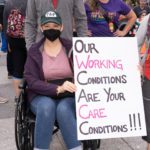‘We Want Change’: Nurses March in D.C. for Better Working Conditions (photos)
By • May 12, 2022 One Comment 4660

“Save one life, you’re a hero. Save 100 lives, you’re a nurse.”
In what was dubbed the “National Nurses March,” thousands of registered nurses from across the country rallied in front of the White House before marching down Pennsylvania Avenue on Thursday, May 12, motivated by anger over deteriorating working conditions in their chosen profession. Staffing shortages, insufficient pay and safety in the workplace were among their grievances.
Lillian Dow, a nurse of six years from Millinocket, Maine, chose to participate. “During the COVID pandemic we all were health care heroes,” she said. “Now, we’re not being paid enough for what we’re doing. [Nurse to patient] ratios have increased which is not safe for our patients. Our patients are suffering.”
Although it is generally understood that more nurses equate to lives saved and fewer complications, the vast majority of states set no limit on the number of sick and injured patients a nurse can be assigned at one time. Ellen Kaufman of Melbourne, Florida, has been at it for 40 years. In the years since, she started out, she said, “We’ve had a complete paradigm shift — nothing is the same. All I really want to do as a nurse is to provide safe patient care and they’re making it very difficult by giving us an overwhelming amount of patients with much more complex illness. Patients are significantly sicker with many comorbidities and we have more of them to take care of so it makes it kind of impossible… there was a problem (even) before COVID. All COVID did was accentuate the problem.” Kaufman lays a good part of the blame on telemedicine during the COVID pandemic, that basically allows the doctor to evaluate a patient remotely over a computer or telephone screen. “Patients aren’t honest….. If you couldn’t see their color, you couldn’t tell if they were anemic.” Sicker patients in hospitals are the end result.
“We want to put a cap on the ratios. You know, in some hospitals, we just have too many patients” says nurse Liz from Greenville, North Carolina, indicating that cap rations for the ICU’s (intensive care units), should be one nurse for two patients. “There are ICU’s where you’ll have three or four patients. That’s unsafe.”
Nurse Jessica Scarlet from Tampa, Florida, has been nursing for 16 years. Five nurses died from COVID in one of the hospitals she once worked in. “So imagine, like you’re walking in the hospital to take care of people and, you know, you could catch this virus and die or give it to your family and somebody could die and we’re still going in,” she said. “There’s at least three states that are passing legislation to cap nurses salaries. Corporations are trying to cap salaries as well. So the the nurse ratio to the patients is just getting crazy. One person can’t do it…. Before COVID on a cardiac floor we had five, maybe six patients, now it’s up to eight or nine … I worked in a hospital in December. We normally had one Charge Nurse per floor. Now there is one Charge Nurse per three floors. (A Charge Nurse is responsible for managing a specific department or nursing unit within a hospital.) … The floor that I was on should have at least four nurses to five nurses a night. There were two.” The motivation is profit at the expense of patients. “They’re making billions,” she added.
Karen Robbins from Byron, New Jersey, stood in front of the White House’s north fence holding a sign reading, “Pizza is NOT Enough.” There were many such signs mocking hospital management’s apparent universal practice of rewarding overworked staff with free pizza in lieu of higher pay. Robbins was “pissed off … because they expect us to work and do everything that they ask us to do and what the public needs but we get nothing in return. Just because they give us pizza doesn’t mean everything goes away. We’ve got to fix our problems, and it’s gonna roll down to the patients. Patients are the ones suffering, not the nurses.”
Threats of physical violence and harassment are also on the rise. Nurses often take the brunt since they are on the front lines and interact most with patients and their families. Nurses support the Workplace Violence Prevention in Healthcare and Social Services Worker Act (HR 1195) which is legislation aimed at protecting healthcare and social service workers from workplace violence. The bill, if passed, would direct OSHA to establish a standard requiring employers in healthcare and social services to develop and implement workplace violence prevention plans and submit annual workplace violence reports.
The issue of safe staffing rations is addressed by H.R.3165/S.1567, the Nurse Staffing Standards for Hospital Patient Safety & Quality Care Act.
“Cap Rations. Not Wages” was emblazoned on a sign held by emergency room nurse Megan from Roanoke, Virginia. “So right now, there aren’t any cap mandated ratios for the amount of patients that I take,” she said. “It is recommended for ER nurses to take one nurse to three patients… Currently right now I take up to five patients.” And there still isn’t enough staffing. “They backflow into the emergency department. Where I work there would be an average of 50 to 60 patients waiting in the E.R. for their bed upstairs. And keep in mind, the amount of beds that we have in the emergency department is anywhere from 70 to 100. So that’s more than half of our beds in the ER. So they would backflow to the waiting room” resulting in much longer wait times… I am surprised people still want to be a nurse. And that breaks my heart because I do truly love my profession. I was hopeful at the beginning of the pandemic. We were celebrated … and then to see the way that has shifted and people began questioning health care workers and a lot of what we do.” Nurses have been taken advantage of says Megan, “for their inate desire to do good.”
Debbie Farnsworth of York, Pennsylvania, retired from nursing last June. “I’ve been nursing for 52 years. Nursing is very much different than it was yesteryear… it’s no longer about the patient and the care that’s given. It’s a numbers game. It’s big business. And it’s all about making that final buck.” According to Fransworth, “patient ratio is important, but patient acuity is even more important.” Patient acuity is defined as a measurement of intensity of nursing care needed by a patient. Generally speaking, patients today are older, sicker, more debilitated and require much more care. When asked how Farnsworth would advise someone getting into the field right now, she replied “I’m a nurse. That’s who I am. And not just what I am. And anybody that becomes a nurse, you’ve got to have it in your heart and you’ve got to give it. It’s all about love and compassion and that’s who you are, not what you are.
Everyone is a potential patient. The plight of our nurses should concern us all.
View a slideshow of Jeff Malet’s photos from the Nurse’s March by clicking on the photo icons below.
- Photo by Jeff Malet.
- Photo by Jeff Malet.
- Photo by Jeff Malet.
- Photo by Jeff Malet.
- Debbie Cash and Ellen Kaufman of Melbourne Florida. Photo by Jeff Malet.
- Photo by Jeff Malet.
- Photo by Jeff Malet.
- Photo by Jeff Malet.
- Photo by Jeff Malet.
- Photo by Jeff Malet.
- Photo by Jeff Malet.
- Photo by Jeff Malet.
- Photo by Jeff Malet.
- Photo by Jeff Malet.
- Megan (left) from Roanoke, Virginia.Photo by Jeff Malet.
- Karen Robbins. “Pizza is not enough” Photo by Jeff Malet.
- Veronica Marshall (left) is the founder of National Nurses March. It started out in a Facebook travel nurse group on January of 2022. Photo by Jeff Malet.
- Photo by Jeff Malet.
- Photo by Jeff Malet.
- Photo by Jeff Malet.
- Photo by Jeff Malet.
- Photo by Jeff Malet.
- Photo by Jeff Malet.
- Photo by Jeff Malet.
- Photo by Jeff Malet.
- Nurse Jessica Scarlet from Tampa Florida. “They’re making billions.” Photo by Jeff Malet.
- Thousands of nurses march down Pennsylavnia Ave. in Washington D.C. Photo by Jeff Malet.
- Photo by Jeff Malet.
- Photo by Jeff Malet.
- Photo by Jeff Malet.
- Photo by Jeff Malet.
- Photo by Jeff Malet.
- Photo by Jeff Malet.
- Photo by Jeff Malet.
- Photo by Jeff Malet.
- Photo by Jeff Malet.
- Photo by Jeff Malet.
- Photo by Jeff Malet.
- Photo by Jeff Malet.
- Photo by Jeff Malet.
- Photo by Jeff Malet.
- Photo by Jeff Malet.
- Photo by Jeff Malet.
- Photo by Jeff Malet.
- Photo by Jeff Malet.
- Photo by Jeff Malet.
- Photo by Jeff Malet.
- Photo by Jeff Malet.
- Photo by Jeff Malet.
- Photo by Jeff Malet.
- Photo by Jeff Malet.





















































Well done